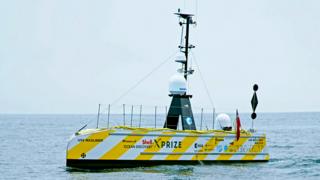[ad_1]
 Image copyright
Image copyright
Rich Edwards, ENP Media
The robot boat was controlled via satellite from SEA-KIT’s HQ in Tollesbury in Essex
A UK boat has just provided an impressive demonstration of the future of robotic maritime operations.
The 12m Uncrewed Surface Vessel (USV) Maxlimer has completed a 22-day-long mission to map an area of seafloor in the Atlantic.
SEA-KIT International, which developed the craft, “skippered” the entire outing via satellite from its base in Tollesbury in eastern England.
The mission was part-funded by the European Space Agency.
Robot boats promise a dramatic change in the way we work at sea.
Already, many of the big survey companies that run traditional crewed vessels have started to invest heavily in the new, remotely operated technologies. Freight companies are also acknowledging the cost advantages that will come from running robot ships.
But “over-the-horizon” control has to show it’s practical and safe if it’s to gain wide acceptance. Hence, the demonstration from Maxlimer.
Image copyright
BigOceanData.Com
The boat mapped a section of seafloor on the edge of the continental shelf
The USV was despatched from Plymouth in late July and sent to a location some 460km (280 miles) to the south-west.
With a multi-beam echo-sounder attached to its hull, the boat mapped more than 1,000sq km of continental shelf area, down to about a kilometre in depth.
This was a segment of seafloor that had essentially no modern data registered with the UK Hydrographic Office.
SEA-KIT had wanted to send the USV across the Atlantic to America for the demonstration, but the Covid-19 crisis made this impossible to organise.
“The project’s overall aim was to demonstrate the capabilities of current technologies to survey unexplored or inadequately surveyed ocean frontiers and despite the planning challenges we faced due to Covid-19, I feel that we have done that. We have proven the true over-the-horizon capability of our USV design and the team are exhausted but elated,” the company’s director of technology, Peter Walker, said.
The USV Maxlimer was originally developed for – and won – the Shell Ocean Discovery XPRIZE.
This was a competition to find the next-generation technologies that could be used to map the global ocean floor. Four-fifths of the sea bottom have yet to be surveyed to an acceptable resolution. Robotic solutions will be essential if we’re to have any chance of closing the knowledge gap.
Image copyright
SEA-KIT International
Artwork: The Netherlands-headquartered multinational Fugro has ordered a fleet of USVs from SEA-KIT
Maxlimer makes use of a communications and control system known as Global Situational Awareness via Internet.
This allows an operator to remotely access CCTV footage, thermal imaging and radar through the vessel, as well as listen live to the USV’s surroundings and even communicate with others in the vicinity.
Maxlimer links to three independent satellite systems to stay in contact with the control room in Tollesbury.
The robot boat moves slowly, at up to 4 knots (7km/h; 5mph), but its hybrid diesel-electric propulsion system is highly efficient.
SEA-KIT CEO and designer, Ben Simpson, told BBC News: “We had a sweepstake on how much fuel would be left in the tank. We thought there was going to be 300-400 litres. It turned out there was 1,300 litres.” In other words, Maxlimer returned to Plymouth with its fuel tank still around a third full.
As well as the European Space Agency, partners on the project included Global Marine Group, Map the Gaps, Teledyne CARIS, Woods Hole Group and the Nippon Foundation-GEBCO Seabed 2030 initiative.
Another partner was Fugro, one of the world’s biggest marine geotechnical companies. The multinational recently announced a contract with SEA-KIT to purchase a fleet of USVs to use in survey work in the oil, gas and offshore wind sectors.
Jonathan.Amos-INTERNET@bbc.co.uk and follow me on Twitter: @BBCAmos
[ad_2]
Source link




